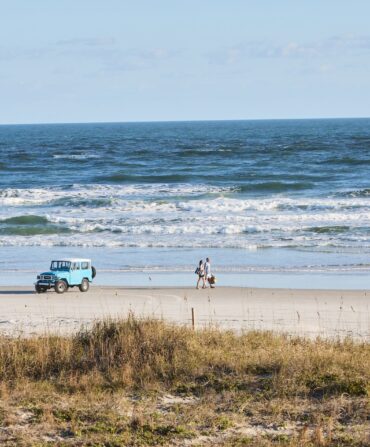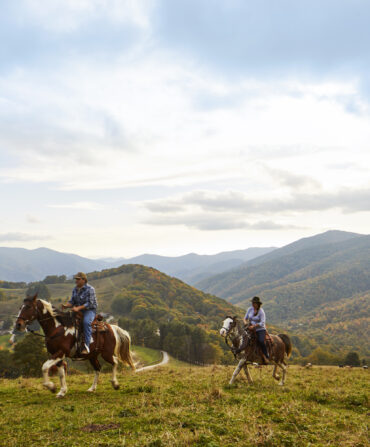Adventures
Boudin without Borders
Surrounded by cane fields and conch sausage in the French territory of Guadeloupe, New Orleans chef Donald Link dines his way through a Caribbean take on Creole cuisine

Photo: Peter Frank Edwards
Elbows on the table at Cochon+, a tin-roofed Caribbean cookhouse with a name similar to one of his own New Orleans restaurants, Donald Link spoons into the eddies of brown-black gravy that shimmer beneath a mound of fricasseed pork shanks and conjures his grandmother Zaunbrecher, standing before her stove in Cajun Country. “I would have put a little flour in there,” Link says, thinking of how her gravy clings to rice. “But that flavor is all there.”
Here on Grande-Terre, the smaller of the two main islands at the center of the Guadeloupe archipelago, Link is three flights and six cups of stale airplane coffee from home. But he has already recognized the first of many connections to the cooking of his native Louisiana. An intense chef with an aquiline nose and a taste for B-movie comedies, Link grew up on the water-girded prairies west of New Orleans in Lake Charles, where his family has long farmed rice and crawfish. Today he directs five New Orleans restaurants, including Cochon, famous for boudin sausage gorged with pork and rice, and Herbsaint, his French-inspired flagship, where duck confit with dirty rice is the money dish.
Link has traveled to Guadeloupe, a French department in the Lesser Antilles, to untangle the knotted roots and branches of Creole cuisine. Originally used by colonizers to refer to people born in the New World, the term Creole can also be applied to racial identity, language, architecture, and, yes, cooking. It’s often associated with New Orleans, where signal dishes such as gumbo z’herbes and oysters Rockefeller are commonly referred to as Creole.
Traveling the Caribbean, from the Dominican Republic to St. Lucia, over the past few years, Link has embraced a broader definition of that term that also encompasses the Cajun cooking of his youth and the cooking of Guadeloupe and other Caribbean islands. All are Creole cuisines, Link says, born of the sixteenth century when native, West African, and European cultures first bonded to create a new global system of ingredients and dishes.
In Guadeloupe, where Renaults and Citroëns thrum along the highways, he bets that French strains of Creole cooking will reveal their imprints in shellfish fricassees that recall Atchafalya Basin shrimp étouffées, gratins of squash that owe debts to Escoffier, and a rainbow of boudins, from pumpkin stippled to pork blood tinged. “All those dishes,” Link says, “were made in the New World.”
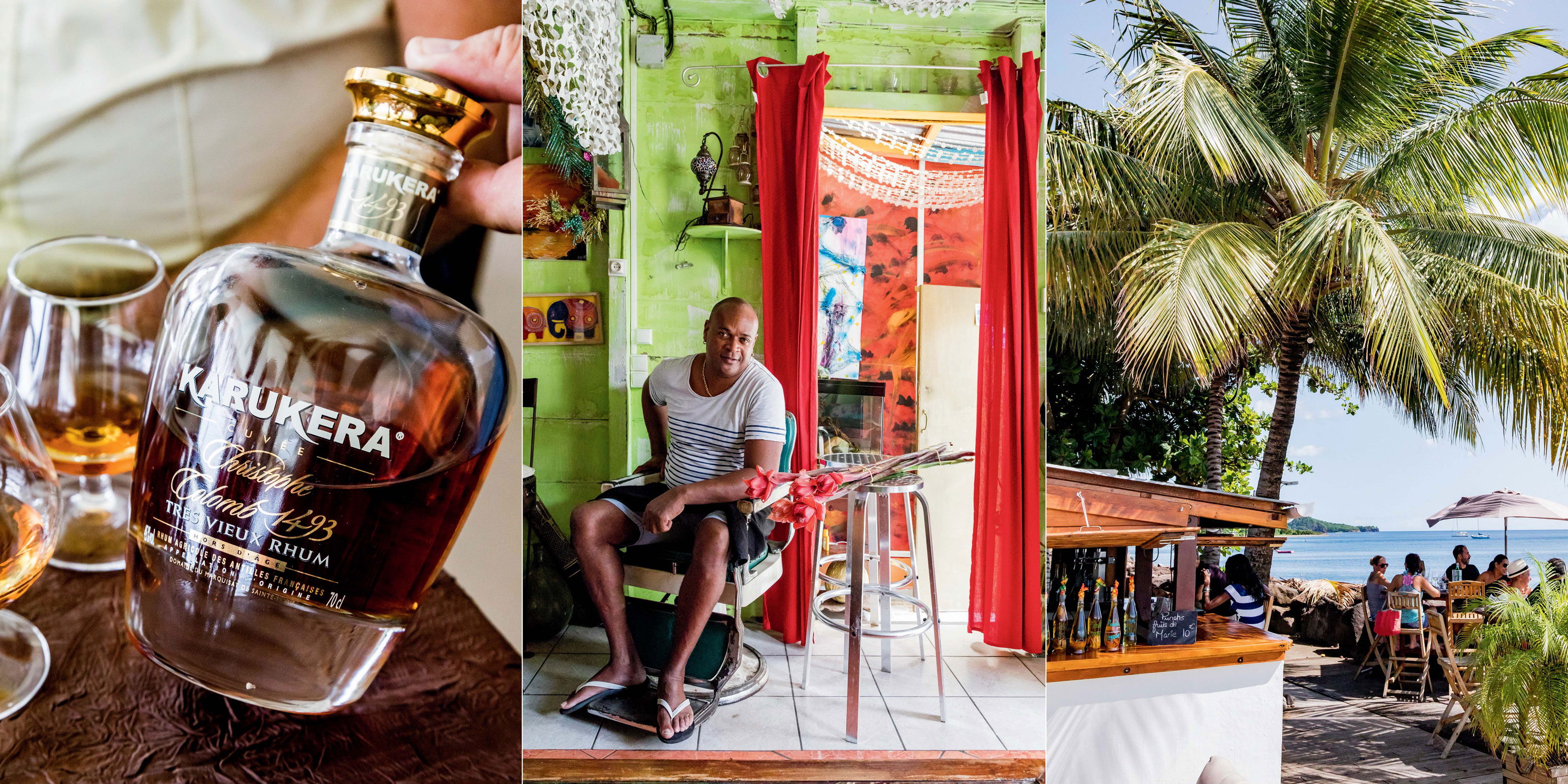
Photo: Peter Frank Edwards
From left: A local aged rum; chef Jean-Claude Magnat at his café in Pointe-à-Pitre; beachside dining at La Touna.
The birth of Creole cuisine was ugly: To grow and process cash crops after they colonized the Americas, Europeans enslaved Africans. That truth is at the heart of this beautiful cuisine. It’s at the heart of Southern cooking, too.
Columbus landed in Guadeloupe, among mangrove swamps and bamboo thickets and sugar-sand beaches, on his second trip to the Americas, in 1493. Native resistance to colonization was fierce. More than a hundred years passed before France established permanent settlements. During the seventeenth century, the French killed off or drove away natives to plant stands of towering cane and build fire-belching sugar refineries. During the nineteenth century, when colonial powers seesawed and colonized people won freedom, the French fought here to preserve slavery.
Today Guadeloupe remembers that tragic history with a museum, set on the site of a former sugar mill in the city of Pointe-à-Pitre. Public sculptures tell the story, too: Solitude, a pregnant woman of African descent who helped lead the 1802 fight against French re-enslavement of these islands, stands tall on a monument-lined avenue. Freedom fighter Louis Delgrès looms at a traffic circle. Facing sure defeat in that same struggle, he torched a gunpowder magazine, committing suicide while slaying hundreds of French troops.
After Link passes that Delgrès statue on the way in from the airport, he stops the car to take a closer look. The City of New Orleans had recently removed the statue of Robert E. Lee from high atop a traffic circle along St. Charles Avenue, and Link wants to see how formerly enslaved people here have used their power to remember the past. At the center of the roundabout, the revolutionary leader and his cohort, rendered in marble, lock arms and stare forward, defiant.
Much like the cooking of Louisiana, the foods of Guadeloupe reflect the impacts of colonization and cultural exchange. Traveling Pointe-à-Pitre on our first day, down streets lined with pastel shotguns and shutter-fronted bungalows, Link eats crab backs stuffed with sweet meat and fiery peppers that bring to mind Jamaica. He devours bowls of beans and rice that taste like they were lifted from back-of-town New Orleans. Boudin, piped with minced conch and moist bread crumbs, eaten at a lean-to in the cane fields on our second day of rambling, is reminiscent of recent Cajun variations stuffed with rice and crawfish. Snacks of accras, fritters flecked with salt cod savored at Evelyne, a dockside restaurant on the road to our beach hotel in the community of Le Gosier, suggest Portuguese trade in dried fish and West African skill in frying.
Over dinner that night at nearby Chez Doudou Rosy, a two-woman café in the neon-fringed shadow of a casino, Link forks into a haunch of goat simmered with turmeric and ginger. As frogs chirp and fireworks light the night sky, he thinks of how much this land, far from Louisiana, sounds and tastes like home.
Before enslaved people began to win their freedom in the Caribbean in the early 1800s, the Creole table was easier to define, Link says, and the connections between the Caribbean and Louisiana were easier to make. Signature dishes included callaloo, a stew of greens, in St. Lucia. And asopao, a gumbo kin, in Puerto Rico. Then came what Link calls the “Creole split.” That’s when cooking in the Caribbean diverged from cooking in Louisiana.
During the middle years of the nineteenth century, sugar growers in the United States recommitted to slavery. Caribbean plantation owners took a different tack, importing indentured laborers from other parts of the world. After the enslavement of Africans ended in Guadeloupe in 1848, workers from India arrived to harvest cane fields and work sugar mills.
Their legacies include the orange and teal madras fabrics in which Pointe-à-Pitre market vendors drape their tables. And the sculpture of Gandhi, walking staff in hand, that greets travelers who drive east from the city to the seaside village of Saint-François. Today’s Caribbean diet, rife with curries and flat breads, reflects the nineteenth-century import of that workforce. So does the dress of the female cooks of African descent who sustain the cooking of Guadeloupe.
We arrive during the annual Fête des Cuisinières, founded in 1916 as a fund-raiser to cover burial costs for female Creole cooks. (Members of social aid and pleasure clubs in New Orleans, famous for dressing in outlandish costumes and parading the streets, band together in comparable ways.) Now the festival centers on a ceremonial August mass, when a Catholic priest confers the blessings of Saint Laurent, patron saint of cooks.
Wearing madras tignons on their heads, the women wrap themselves in white skirts. Around their waists, they tie royal-blue aprons, embroidered with rabbits, fish, and other ingredients, accessorized with bright tin trinkets shaped like box graters, trivets, and grills. High heels clicking on tile, the women exit the mass as video crews crowd the plaza and a trombone shout band bleats.
The message embedded in the moment is clear: Women have sustained Guadeloupe. And women have sustained Creole cuisine. Southerners are now awakening to the vital role that female cooks of African descent have played in cultural life. In Guadeloupe, formal recognition of their work spans more than a century.
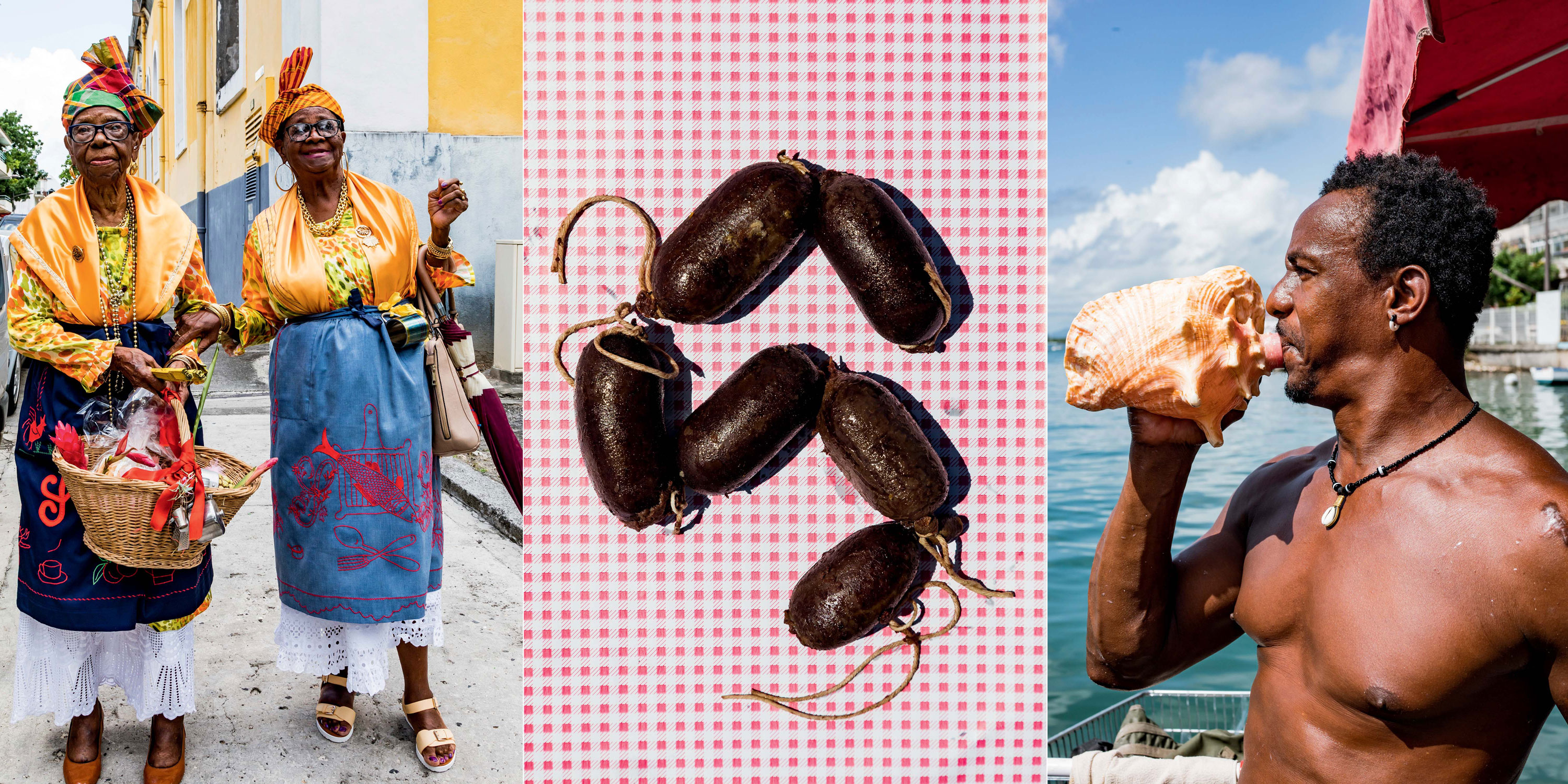
Photo: Peter Frank Edwards
From left: Creole cooks at the annual Fête des Cuisinières; links of boudin noir; a market vendor sounds a conch.
Traveling Pointe-à-Pitre, caroming down alleyways that pass for streets, passing whitewashed Catholic churches and derelict shot-and-a-beer bars, we arrive at the storefront café of Jean-Claude Magnat, chef and proprietor of An Chodyè La. Inspired by his great-great-grandmother, born Lucille Deris, Magnat transformed her narrow home into a neighborhood café. Washing clothes in the early 1800s, Deris bought her freedom and that home. Working the space where she scrubbed the blouses and drawers of the gentry, Magnat cooks dishes that recall the mid-eighteenth-century Paris moment when the first restaurants emerged.
Back then, restorative soups were central to menus. Today Magnat serves eight soups. From a battery of hot boxes atop the stove, he ladles out a liver soup, sweetened with squash and spiked with pickled capers. Piebald sea snails float in a clear glass bowl of onion-threaded broth. Head-on shrimp, antennae reaching toward the ceiling, bob in fish stock. Scotch bonnet peppers add a sneaky heat to a vegetable puree. Tight white dumplings drift in an oxtail broth.
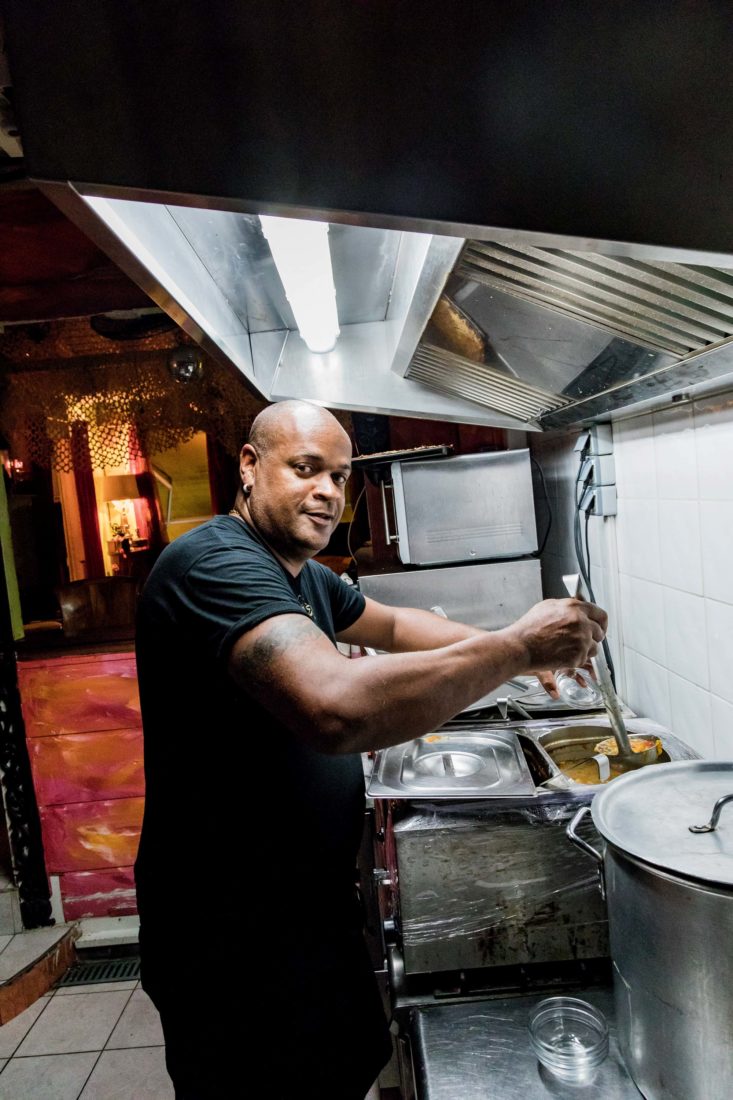
Photo: Peter Frank Edwards
Jean-Claude Magnat in the kitchen at An Chodyè La.
Outside, a man walks the narrow streets, selling live spiny lobsters from a croker sack. In the back room, a family reunion draws a crowd from Angola and Paris. An Chodyè La delivers the French colonial linkage that often defines Creole cuisine. Served with bowls of croutons, these soups telegraph how European and West African peoples and techniques entwine.
Coursing Guadeloupe, we try various boudins, eating each nub with a douse of onion and vinegar that locals call sauce chien. Down the street from An Chodyè La we stop at a market that advertises fish boudin, conch boudin, and smoked herring boudin. During lunch at La Touna, a beachside café in Basse-Terre reached by driving up and over a volcano and alongside a waterfall that takes its name, tellingly, from the French word for crawfish, Link snacks on a stub of boudin rouge that blushes maroon with blood. “This tastes like they use MSG,” he says, remembering, almost wistfully, that many of the best boudins in Cajun Country also rely on that flavor enhancer.
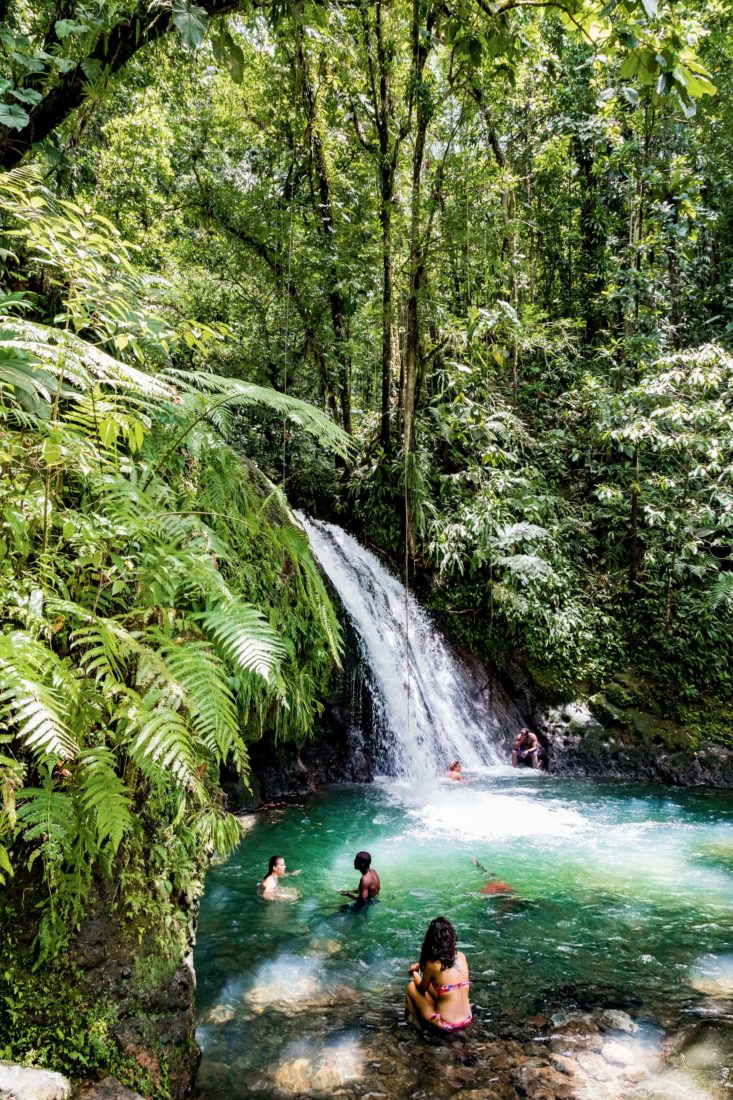
Photo: Peter Frank Edwards
Locals cool off at a roadside waterfall.
Boudin is omnipresent here. But even as we begin to worry through our plans for departure, Link has yet to identify his platonic ideal. On Sunday morning, hours before our crew gathers at the airport, we drive east from Le Gosier along a narrow road that hugs the seawall. In the town of Sainte-Anne, we find what Link has been looking for.
The scene is idyllic: Down the street, a coconut vendor machetes fruit for customers who squat on stools to spoon creamy white meat from splintered shells. Beneath a tarp strung from a pickup truck cab, a man in a white smock feeds cane into a roller mill as sweet green juice sluices into a bucket and a pile of bagasse masses at his feet. At a stand by the seawall, a woman from Mauritius wearing a madras tignon sells accras and fruit juices and flirts with passersby.
Set beneath a logo-plastered tent, in sight of a fleet of oceangoing Jet Skis, Boudins Périanin is an artisanal standard-bearer. Wearing a starched white uniform with a maroon boudin stitched on the left shoulder like an epaulet, the proprietor, Erick Périanin, takes pride in upholding the traditional methods his family has practiced since 1956. When Link approaches, Périanin greets him with a knob of boudin rouge, wrapped elegantly in a white paper napkin.
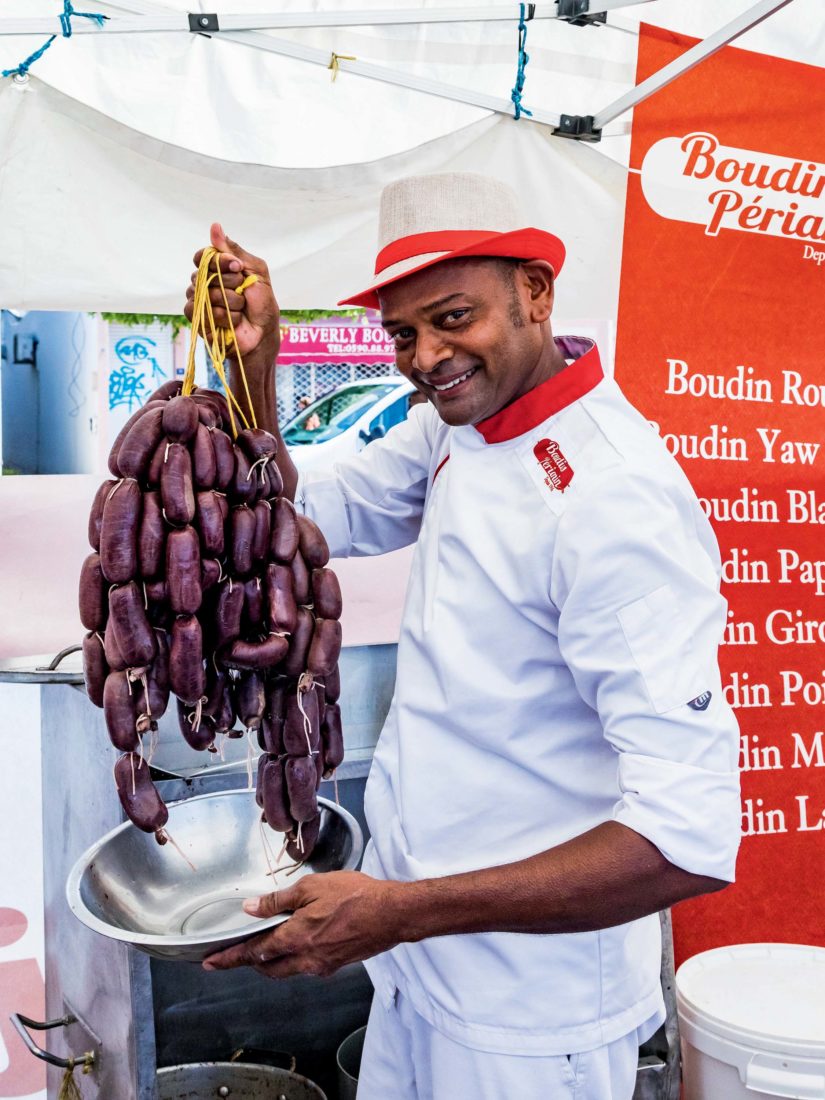
Photo: Peter Frank Edwards
Boudin maker Erick Périanin shows off the goods.
Périanin still cooks sausages over a wood fire. And his boudin rouge pimenté, warmed with allspice, is correctly flush with chile peppers. But Périanin also tweaks traditions. His green papaya boudin tastes slightly vegetal. His pumpkin boudin evokes an extruded squash casserole. This is the food, at once traditional and modern, that lured Link to fly south. Creole exchanges made this place and these sausages, just as they made the boudin on which Link built
his reputation.
Link thought his Creole quest might end here in Guadeloupe, where the French culinary imprint is comparable to Cajun Country. Traveling the Caribbean, he had already tasted his way through marriages of Spanish and West African cookery. But as Link falls in conversation with two of the women who work Périanin’s boudin shop, handing out samples with tongs, he learns that cooks in Colombia make pork boudin, too. That might compel him to expand his definition of Creole to include South America. That might inspire him to travel to Cartagena. Maybe Medellín.

Photo: Peter Frank Edwards
Visitors gather at Périanin’s seaside tent.
Before we drive to the airport, Sunday lunch at La Porte des Indes, an open-air restaurant on the southeastern coast of Grande-Terre, cross-beamed with mahogany and decorated with bejeweled saris, delivers a final taste of the creolized cultures that tether Louisiana and Guadeloupe. “That could work at Cochon,” Link says, knifing into a crescent of shrimp that chef Arthur Karioua has stuffed with a curried grind of lamb and eggplant.

Photo: Peter Frank Edwards
Chef Donald Link samples dishes at La Porte des Indes.
Between bites of shrimp biryani, before Link samples a crème brûlée perfumed with cardamom, he diverts the afternoon conversation to the movie Hot Tub Time Machine 2 and to his favorite New Orleans red beans and rice dish, served at the swamp exhibit at the zoo. “It tastes great,” he says, “with a can of Coors.”
“It’s all Creole,” Link says of those red beans and that crème brûlée, if you open your mind to the complexities of history and global trade, and to the complicated fabric of cultures that have long interwoven in Louisiana and across the Caribbean rim. He’s unsure whether trekking to South America to eat boudin will reinforce or weaken his theories. But he knows he has to go. As a native of Louisiana, called to cook and speak for his place, Link wants to get this right.
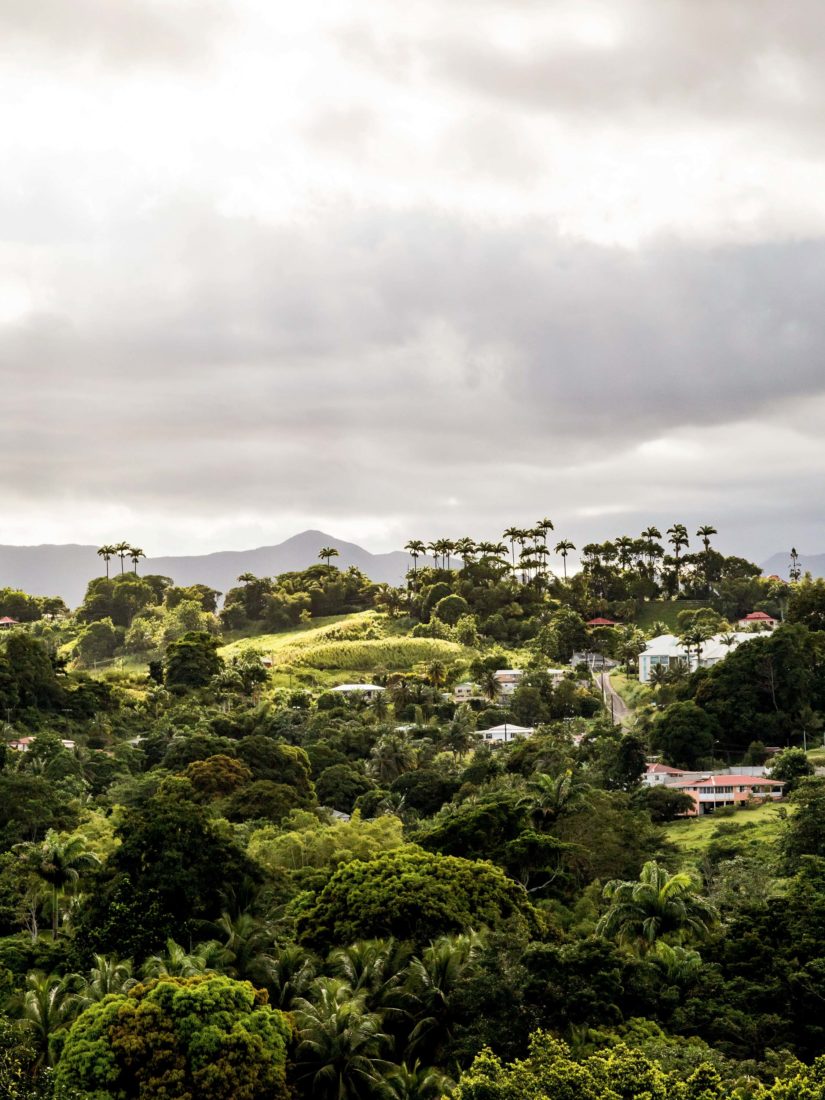
Photo: Peter Frank Edwards
Guadeloupe’s hilly terrain.


